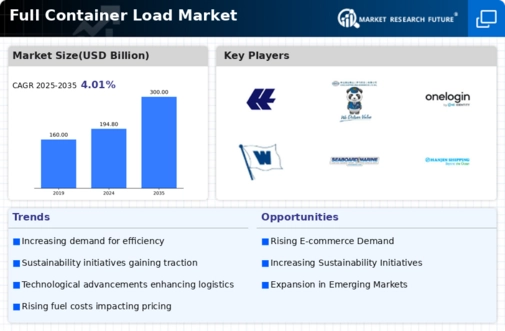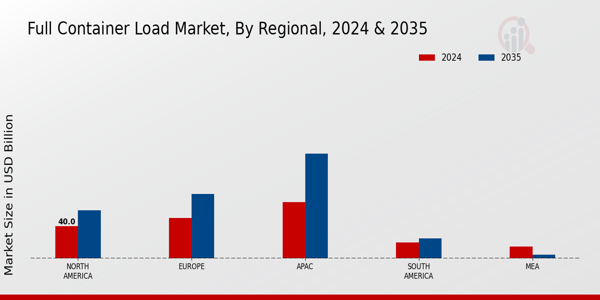Expansion of E-commerce
The rapid growth of e-commerce is a significant driver for the Global Full Container Load Market Industry. As online shopping continues to gain traction, the demand for efficient logistics solutions to handle increased shipment volumes rises. E-commerce giants are increasingly relying on full container loads to optimize their supply chains and reduce shipping costs. This trend is evident in the surge of containerized shipments, which are expected to contribute to the market's growth trajectory. The Global Full Container Load Market is likely to benefit from this e-commerce boom, with projections indicating a market size of 300 USD Billion by 2035, driven by the need for timely and reliable delivery services.
Market Growth Projections
The Global Full Container Load Market is poised for substantial growth, with projections indicating a market size of 300 USD Billion by 2035. This growth is underpinned by a compound annual growth rate (CAGR) of 4.01% from 2025 to 2035. Factors contributing to this expansion include the increasing demand for containerized shipping, advancements in logistics technology, and the rise of e-commerce. The market's trajectory suggests that stakeholders should prepare for evolving dynamics and invest in innovative solutions to capture emerging opportunities. As the Global Full Container Load Market continues to expand, it will likely play a pivotal role in shaping the future of international trade.
Growing Global Trade Volume
The expansion of global trade volume is a primary driver for the Global Full Container Load Market Industry. As economies recover and develop, the demand for containerized shipping increases. In 2024, the market is projected to reach 194.8 USD Billion, reflecting the rising need for efficient logistics solutions. The facilitation of trade agreements and the establishment of new trade routes further bolster this growth. For instance, the Regional Comprehensive Economic Partnership (RCEP) enhances trade among Asia-Pacific nations, potentially increasing container shipments. This trend suggests that the Global Full Container Load Market will continue to thrive as international trade dynamics evolve.
Infrastructural Developments in Ports
Infrastructural developments in ports are crucial for the Global Full Container Load Market Industry. Upgraded port facilities and enhanced logistics infrastructure facilitate smoother operations and reduce bottlenecks in container handling. Governments worldwide are investing in port modernization projects to accommodate larger vessels and improve efficiency. For instance, the expansion of the Panama Canal has significantly increased shipping capacity, allowing for larger container ships to transit. This development not only enhances global shipping routes but also supports the anticipated growth of the Global Full Container Load Market, which is projected to reach 194.8 USD Billion in 2024, as improved infrastructure attracts more shipping activities.
Sustainability Initiatives in Shipping
The increasing emphasis on sustainability is reshaping the Global Full Container Load Market Industry. Shipping companies are adopting greener practices to reduce their carbon footprint, responding to regulatory pressures and consumer demand for environmentally friendly options. Initiatives such as using alternative fuels and optimizing shipping routes to minimize emissions are becoming commonplace. For instance, the International Maritime Organization (IMO) has set ambitious targets for reducing greenhouse gas emissions from shipping. This shift towards sustainable practices not only aligns with global environmental goals but also enhances the competitiveness of companies within the Global Full Container Load Market, as consumers increasingly prefer eco-conscious logistics providers.
Technological Advancements in Shipping
Technological innovations in shipping logistics are transforming the Global Full Container Load Market Industry. The adoption of automation, artificial intelligence, and blockchain technology enhances operational efficiency and transparency. For example, automated port facilities reduce turnaround times, allowing for quicker loading and unloading of containers. Furthermore, the integration of IoT devices enables real-time tracking of shipments, improving supply chain visibility. These advancements not only streamline operations but also reduce costs, making container shipping more attractive. As these technologies proliferate, they are likely to contribute to the projected market growth, potentially reaching 300 USD Billion by 2035.





















Leave a Comment